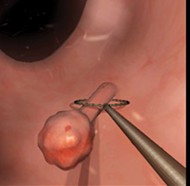Treatment Of Uterine Polyps
Management Of Endometrial Polyps
![]()
Treatment Of Uterine Polyps |
 Polypectomy: Removal of uterine polyp with electrical wire. |
Treatment Of Uterine PolypsContents • How Are Uterine Polyps Treated? |
|
Topic Overview Guide to Polyps Uterine Polyps Causes Symptoms |
How Are Uterine Polyps Treated?
If you are diagnosed with one or more uterine (endometrial) polyps, you are likely to ask your doctor "what is the chance the polyp is cancerous?” and “is removal necessary?”. In the first instance, the risk of cancer is less than 1 percent - fortunately the vast majority of both uterine and cervical polyps are benign. The second question is a little harder to answer because there are no established treatment protocols. Studies show that postmenopausal women with symptoms (primarily vaginal bleeding) are most at risk of polyps turning cancerous; and so removal is recommended. If polyps become very large and cause problems such as infertility (see symptoms of uterine polyps), then treatment is also recommended. In asymptomatic women (those displaying no symptoms), the benefit of removing polyps is less clear. Around 25 percent of polyps disappear spontaneously without treatment over the course of 12 months. Smaller polyps, that is, those under 1cm in size, are most likely to regress because they don't have a central feeding blood vessel. Even in asymptomatic postmenopausal women, small polyps are unlikely to be malignant and observation may be the first line of treatment. However, those with a family history of endometrial cancer should consider polyp removal.
Is A Large Polyp More Likely To Be Cancerous? Medications For Treating Uterine Polyps Hormone therapy can help to treat polyps and even prevent their formation, but success is limited and as soon as therapy is stopped, the polyps start growing again. Therapies include the use of a levonorgestrel releasing intrauterine device (Mirena coil). Read about the causes of uterine polyps and the effects of estrogen. Investigation (diagnosis) and the removal of polyps is usually carried out under general anesthetic (95 percent of cases, 5 percent are carried out with epidural anesthesia). In the past the only treatment available was a hysterectomy. Fortunately these days, new and less drastic medical procedures are available.
Dilation And Curettage (D&C) Alternative therapies such as naturopathic medicine may help in shrinking the size of polyps and in so doing, reduce unwanted symptoms. A typical approach of a naturopath would be first to identify and address potential underlying causes in your lifestyle - such as obesity and diet. Where appropriate, a number of different therapeutic treatments will be suggested, including:
|
| Related Articles on Polyps
For more on related conditions, see the following: • Treatment of cervical polyps and causes of cervical polyps. Back to Homepage: Womens Health Advice |
|
WOMENS HEALTH ADVICE: ABOUT POLYPS |